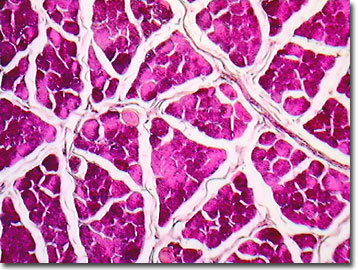Brightfield Digital Image Gallery
Hairy Mammal Skin
In contrast to the largely naked skin of humans, most mammals feature hairy skin. The pelt, fur, or skin is often vital to an animal for its own survival, particularly in colder, wetter climates. The characteristics of an animal's skin, however, make some creatures, such as seals, goats, and cattle, valuable to humans for clothing or shelter.

Unlike the feathers and scales of birds and the different scale types in the fish, hair is a uniquely mammalian characteristic of epidermal origin that helps the homeotherms maintain their internal body temperatures, despite environmental conditions. Many mammals, for example the wolf and the domestic dog, possess two types of hair, coarser guard and finer, softer underfur. In white-tailed deer and pronghorn antelope, the hairs are hollow and air-filled, acting as additional insulation against harsh winters. The muskox boasts the longest mammal hair in North America, guarding the insulating wool layers that enable it to survive the frigid winters of the Arctic tundra.
Unusual adaptations for mating and defense, such as the rhinoceros' horn, the pronghorn antelope's sheath, and the hooves of the ungulates, such as the white-tailed deer and the domesticated cow, are actually not bone derivatives as are antlers, turtle shells, and armadillo plates, but rather keratinized hair derivatives of epidermal origin. Porcupines do not feature spines, but instead have highly modified epidermal hairs that offer tremendous protection from potential predators. Even whales feature hairy skin, but it is greatly reduced to just a few coarse facial hairs since they largely depend on their blubber for warmth.
The typical mammalian hairy skin (or fur) includes the living follicle (the hair pit), sebaceous (oil) glands that help maintain the moisture and flexibility of the hair, sweat glands that provide water, and the threadlike growth that is called hair or fur. Hair was probably a primitive sensory device, and whiskers on cats, dogs, and moles still retain the function for sensing items that are nearby, and for orientation. Demonstrating coevolution, ectoparasites, such as lice, are well adapted for clinging to and feeding on mammalian hair. Unique to the animal kingdom, the very slow and hairy sloths of the Amazon canopy host commensal algae on their fur, with the sloths providing shelter, while the simple plants bestow the sloths with camouflage.
Contributing Authors
Cynthia D. Kelly, Thomas J. Fellers and Michael W. Davidson - National High Magnetic Field Laboratory, 1800 East Paul Dirac Dr., The Florida State University, Tallahassee, Florida, 32310.
BACK TO THE BRIGHTFIELD IMAGE GALLERY
BACK TO THE DIGITAL IMAGE GALLERIES
Questions or comments? Send us an email.
© 1995-2025 by Michael W. Davidson and The Florida State University. All Rights Reserved. No images, graphics, software, scripts, or applets may be reproduced or used in any manner without permission from the copyright holders. Use of this website means you agree to all of the Legal Terms and Conditions set forth by the owners.
This website is maintained by our
Graphics & Web Programming Team
in collaboration with Optical Microscopy at the
National High Magnetic Field Laboratory.
Last Modification Friday, Nov 13, 2015 at 01:19 PM
Access Count Since September 17, 2002: 21462
Visit the website of our partner in introductory microscopy education:
|
|
